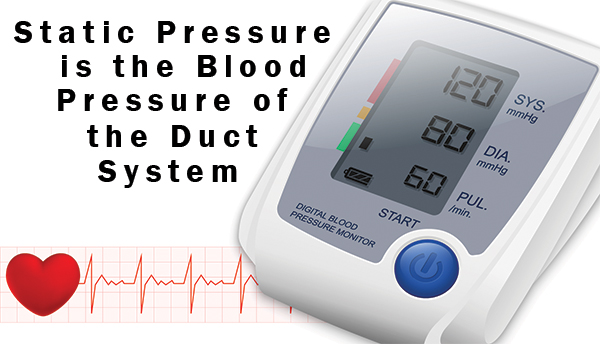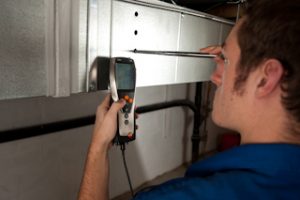
Rob Falke, president, NCI
When replacing HVAC equipment, better service companies offer duct upsize and system performance upgrades as an option to their customers. These upgrades allow the duct system to perform closer to the level of efficiency claimed by the equipment manufacturer. Let’s take a look at the steps necessary to effectively upsize a residential duct system.
Why Upsize a Duct System?
Field data supports the need to upsize duct systems. In the U.S., the average residential HVAC system static pressure 0.83” w.c. This pressure is 165% higher than the maximum static pressure the typical residential fan is rated to work against.
You can best express the dangers of high static pressure to your customers, and justify the need for upsizing a duct system, by comparing static pressure to blood pressure. In short, a system static pressure of 0.83” is comparable a blood pressure reading of 200 over 130.

How to Redesign a Duct System
There are volumes of information about how to design a new HVAC system, but nothing much that addresses how to redesign one. It would take many pages to completely detail the process, but let’s take a stab at the basic ideas.
First A Bit of Testing
Most of us redesign HVAC systems only when it’s time to change out the equipment. If you think about it, a critical step is to assess the operation of the existing system first. We call it test-in. Without testing the operating condition of the existing system, you have no starting point.
Sure, you can assume the existing duct system was designed and installed perfectly, but most of us know where that leads. Pretesting enables you to assess the existing system before you redesign it.
System values that should be tested include total external static pressure and system component pressure drops. You should also take several system airflow readings.
System values that should be tested include total external static pressure and system component pressure drops. You should also take several system airflow readings. Compare this data against equipment manufacturer’s published data and system design numbers to evaluate existing system performance.
Typically, you’ll find static pressure to be high and airflow really low — even on systems your company installs and services. Or, you can continue along your merry way assuming your systems are performing perfectly.
Design and Sell
If possible, complete this process in the presence of your customer. Many of you have found this to be a terrific educational and sales opportunity. This often produces an average closing rate over 70% for those who master the approach.
Invite your customer to participate, or at least watch the testing, and record the test data. Also, allow them input into the design process. If the spouse wants another 20 cfm in their office, see that they get it (and a damper to adjust it later, if needed.)
It’s their decision and money, and they must decide to give you the job. Encourage them to participate in the process. Use consumer-friendly language and report forms to allow them to help test and participate in the redesign process.
Check Fan Size and Static Pressure Capacity
This is an essential step and foundation of duct upsizing. By taking time to check fan capacity and measuring operating system total external static pressure you will immediately see the need to upsize duct. These steps assure your redesign will deliver a system that actually works.
Room-By-Room Airflow
Most of you won’t measure airflow in every room, but will take a balancing hood and measure airflow into rooms where your customer is concerned about comfort. Estimate approximate airflow needed for that room and then share that information with your customer before measuring the supply register to that room.
Then have your customer use the balancing hood to measure room airflow. Usually 120 cfm or so is needed. When your customer measures airflow, the hood usually displays somewhere below 50 cfm.
When this happens, your customer is astonished and you are the hero for finally helping them see why this room has been so uncomfortable for so long. This helps your customer understand air is the stuff that moves through the system.
Typical Duct Upsize Actions
Let’s cut to the chase, typical duct upsize actions include:
Return Ducts. Most return duct systems are undersized as confirmed by static pressure and airflow testing. The solution is way too simple; increase return duct capacity by installing a new 14” duct into an open area of the home directly to the return plenum.
Supply Ducts. Several rooms will be short on airflow. The last step in design may be tearing out a few ducts and replacing them with larger ones or adding new oversized ducts to increase supply duct capacity to rooms with low airflow.
Design is a concept of what should happen. Testing verifies each idea of the design and confirms that system performance. To design only is just to dream and hope a great system will leap into existence.
As you can see, this approach is pretty simple since you already have an existing duct system. To summarize, here are five steps:
- Measure how well it’s working.
- Determine where you are short on duct capacity
- Add or upsize return duct capacity to an open area of the home
- Add or upsize supply duct capacity in the rooms that need more air
- Test out to be sure your solutions improved the system.
And you’re done.
Build and Test the System
In conclusion, design is a concept of what should happen. Testing verifies each idea of the design and confirms that system performance. To design only is just to dream and hope a great system will leap into existence. If you’re angry about this statement, you’re an over-confident designer detached from reality. If you chuckle a little at this statement, I love ya, man. You are building systems that others only dream about.
Rob “Doc” Falke serves the industry as president of National Comfort Institute — an HVAC-based training company and membership organization. If you’re an HVAC contractor or technician interested in a free article on how to measure static pressure, contact Doc at robf@ncihvac.com or call him at 800-633-7058. Go to NCI’s website at nationalcomfortinstitute.com for free information, articles, and downloads.

